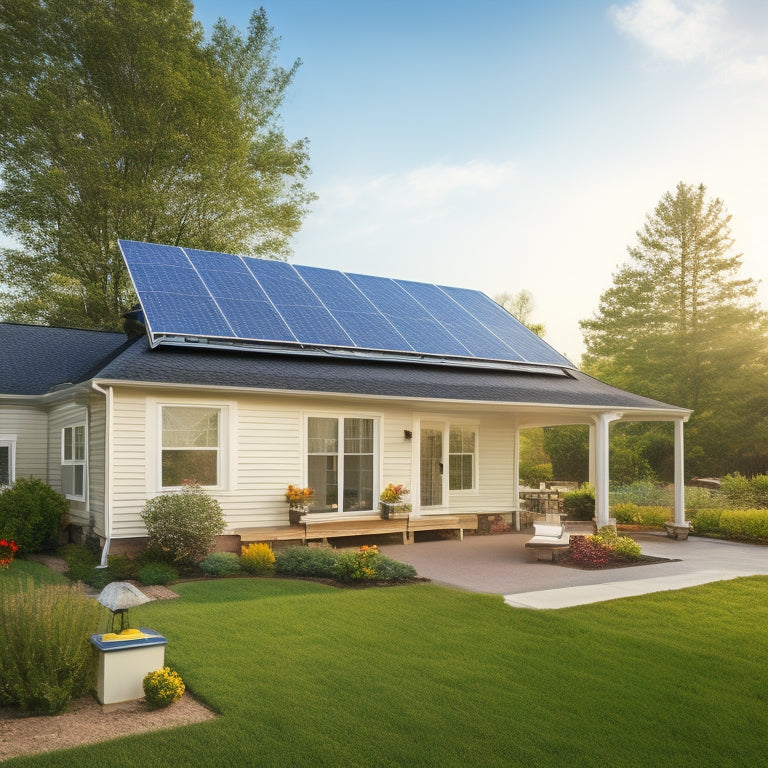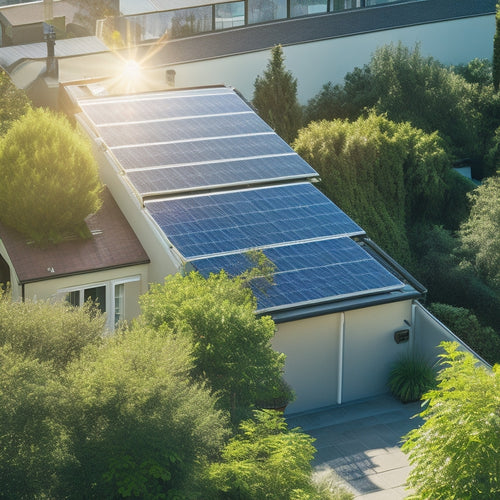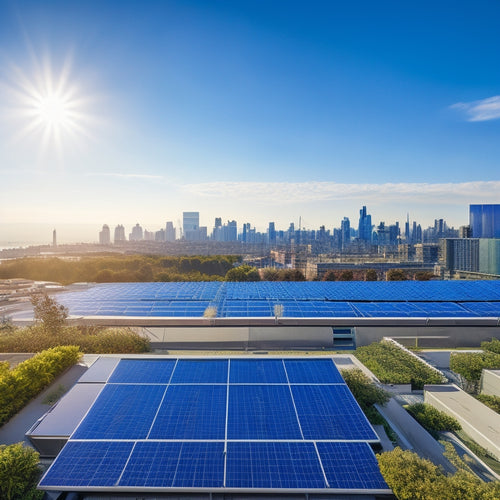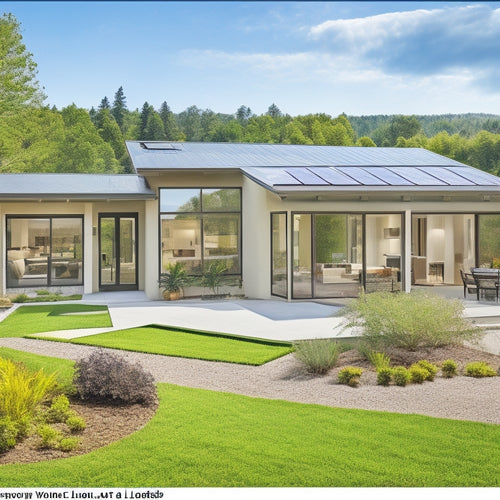
What's the Average Cost of Solar Panel Installation?
Share
On average, you can expect to pay between $15,000 to $30,000 or more for a solar panel installation, depending on the system size, equipment quality, and installation complexity. With a well-designed system, you'll typically save between $400 and $1,000 per year on your electricity bills. Keep in mind that labor costs, material sourcing, and local regulations all impact the final price. To get the best value for your money, it's essential to understand the factors that influence installation prices. Now, dive deeper into the specifics of solar panel costs and discover how you can optimize your investment.
Key Takeaways
• The average cost of solar panel installation ranges from $15,000 to $30,000 or more, depending on system size and installation complexity.
• The cost per watt (CPW) of solar panels ranges from $2.50 to $3.50, with high-efficiency panels being pricier but offering better performance.
• Labor costs, material sourcing, and local building codes and regulations also impact the overall installation cost.
• The size of the solar panel system directly affects the installation cost, with larger systems often having a lower cost per watt.
• Regional incentives, such as the Solar Investment Tax Credit (ITC), can significantly reduce the upfront installation cost of solar panels.
Understanding Solar Panel Costs
When planning to install solar panels, you'll likely want to know the total cost of the system, including the hardware, labor, and permits, which can range from $15,000 to $30,000 or more for a typical residential installation. This upfront investment can seem overwhelming, but it's crucial to take into account the long-term solar savings and energy efficiency benefits that come with harnessing renewable energy.
As you weigh the costs, keep in mind that solar panels can greatly reduce your energy bills. In fact, a typical solar panel system can save homeowners between $400 and $1,000 per year on their electricity bills. Over the system's lifespan, these savings can accumulate to tens of thousands of dollars.
Additionally, solar panels can increase your property value, making your home more attractive to potential buyers if you decide to sell in the future.
Factors Affecting Installation Prices
As you prepare to invest in a solar panel system, you'll want to understand the factors that affect the installation prices, which can vary greatly depending on your location, roof size, and equipment choices. These factors can have a considerable impact on the overall cost of your solar panel installation.
Some of the key factors affecting installation prices include:
-
Labor Costs: The cost of hiring and training a team of professionals to install your solar panel system can vary depending on the complexity of the installation, the location, and the installer's reputation.
-
Material Sourcing: The type and quality of equipment you choose can greatly influence the installation cost. High-efficiency panels, for instance, may be more expensive than standard ones.
-
Local Building Codes and Regulations: Compliance with local building codes, permits, and inspections can add to the overall cost of the installation.
Understanding these factors will help you make informed decisions about your solar panel installation and ensure you get the best value for your investment. By considering these factors, you can optimize your solar panel system to meet your energy needs while staying within your budget.
Average Cost of Solar Panels
Determining the average cost of solar panels requires taking into account various system sizes, with prices ranging from around $2.50 to $3.50 per watt, depending on the quality of equipment and installation company. As you explore different options, you'll find that high-efficiency panels with premium materials and advanced technology tend to be pricier, while more affordable options may compromise on energy efficiency.
A typical residential solar panel system can range from 3 to 10 kilowatts, with prices varying accordingly. When calculating the total cost, you should also factor in the cost of inverters, mounting hardware, and other balance-of-system components.
To ensure optimal energy efficiency, it's important to take into account solar panel maintenance costs, which can add up over time. Regular cleaning, inspections, and potential repairs can help maintain your system's performance and extend its lifespan.
As you weigh the costs, keep in mind that energy-efficient solar panels can provide long-term savings on your utility bills. By choosing a high-quality system and factoring in maintenance expenses, you can maximize your return on investment and enjoy a sustainable source of clean energy.
Installation Costs by Location
Your geographic location greatly impacts the installation costs of your solar panel system, with varying labor costs, permitting fees, and local incentives influencing the final price tag. As you contemplate installing solar panels, it's crucial to understand how your location affects the overall cost.
Here are some key factors to ponder:
-
Urban regions: Installation costs tend to be lower in urban areas due to higher competition among installers, leading to more competitive pricing. Additionally, urban areas often have more established infrastructure, reducing installation complexity and costs.
-
Rural disparities: In contrast, rural areas typically have higher installation costs due to longer travel distances, limited installer availability, and increased complexity in maneuvering local permits and regulations.
-
Regional incentives: Local and state governments often offer incentives, such as tax credits or rebates, which can greatly reduce the upfront cost of installation. Understanding these regional incentives can help you optimize your investment.
System Size and Cost Impacts
As you consider installing solar panels, you'll want to understand how system size impacts the overall cost.
The size of your solar panel system, measured in watts (W), directly affects the total installation cost.
You'll need to weigh the benefits of larger systems, which can generate more electricity, against the increased upfront costs.
System Size Variations
Based on your location, energy requirements, and available roof space, you'll need to select a solar panel system size that balances your energy needs with budget constraints. The system size you choose will have a major impact on the overall cost of your solar panel installation.
When it comes to system size variations, you'll want to take into account the following factors:
-
Panel Efficiency: More efficient panels can produce more power per unit area, allowing for smaller systems that still meet your energy needs.
-
System Scalability: Larger systems can be more cost-effective, but may not be suitable for smaller roofs or lower energy demands.
-
Roof Space and Orientation: The amount of available roof space and its orientation (south-facing, for example) will influence the system size you can accommodate.
Cost per Wattage
When calculating the cost of a solar panel installation, the cost per wattage (CPW) is an important metric that directly correlates with system size, influencing the overall expense of the project. As you contemplate your solar panel installation, understanding CPW is vital.
CPW is typically measured in dollars per watt ($/W) and varies depending on the system size, inverter efficiency, and power output. A smaller system with a lower power output will have a higher CPW compared to a larger system with a higher power output.
For instance, a 3 kW system might've a CPW of $2.50/W, while a 10 kW system might've a CPW of $1.80/W. This is because larger systems can take advantage of economies of scale, reducing the overall cost per watt.
Inverter efficiency also plays a role, as a more efficient inverter can increase the power output, leading to a lower CPW. As you evaluate solar panel installation options, be sure to take into account CPW to make sure you're getting the best value for your investment.
Equipment Quality and Pricing
As you explore equipment options, you'll notice that high-efficiency solar panels come at a premium, but they can greatly enhance your system's energy output.
Meanwhile, mid-range systems offer a balance between quality and affordability, making them a popular choice for many homeowners.
If budget constraints are a concern, you can also consider budget-friendly alternatives that still provide reliable performance at a lower cost.
High-Efficiency Panel Options
You'll find high-efficiency solar panels, boasting efficiencies of 20% or higher, from top-tier manufacturers like SunPower and Panasonic, with prices ranging from $2.50 to $3.50 per watt, depending on the specific model and features. These premium panels offer superior performance, ensuring maximum energy yield and a longer lifespan.
Some key benefits of high-efficiency panels include:
-
Enhanced Panel Durability: With a more efficient design, these panels can withstand harsh weather conditions and last longer, providing a higher return on your investment.
-
Increased Energy Yield: High-efficiency panels can generate more power per hour of sunlight, resulting in higher energy yields and lower electricity bills.
-
Compact System Design: With more power per panel, you'll need fewer panels to achieve your desired energy output, reducing the overall system size and installation costs.
Mid-Range System Costs
Mid-range solar panel systems, offering a balance between quality and affordability, typically feature equipment priced between $2.00 and $2.50 per watt, depending on the manufacturer and specific model chosen. This range provides a sweet spot for homeowners seeking a reliable system without breaking the bank.
| Panel Efficiency | System Durability | Cost per Watt |
|---|---|---|
| 18%-20% | 25 years | $2.10 |
| 19%-21% | 25-30 years | $2.30 |
| 20%-22% | 30 years | $2.40 |
| 21%-23% | 30-35 years | $2.50 |
| 22%-24% | 35 years | $2.60 |
When opting for a mid-range system, you'll likely see panel efficiencies ranging from 18% to 24%. This translates to a moderate level of energy production. Additionally, these systems often boast system durability of 25-35 years, ensuring a reliable performance over time. By understanding the trade-offs between panel efficiency, system durability, and cost per watt, you can make an informed decision for your solar panel installation.
Budget-Friendly Alternatives
For homeowners on a tighter budget, budget-friendly alternatives offer a more affordable entry point into solar energy, with equipment priced between $1.50 and $2.00 per watt, depending on the manufacturer and specific model chosen. You'll find that these systems often use lower-efficiency panels or less advanced inverters, which can still provide significant energy savings.
Some budget-friendly options to explore include:
-
Rent-to-own solar programs: These allow you to rent solar panels for a fixed monthly fee, with the option to purchase the system at a later date.
-
Solar leases: Similar to rent-to-own programs, solar leases let you use solar energy without owning the equipment, with a fixed monthly payment.
-
Used or refurbished solar equipment: You can opt for pre-owned or refurbished solar panels and inverters, which can be much cheaper than buying new.
Keep in mind that while these alternatives can save you money upfront, they may not provide the same level of energy efficiency or long-term savings as higher-end systems. Be sure to weigh the pros and cons before making a decision.
Installation Company Pricing
When researching solar panel installation companies, it's important to compare prices among different providers, as company pricing can vary greatly depending on factors such as system size, equipment quality, and installation complexity.
You'll want to assess companies with a strong reputation and adherence to industry standards. A reputable company will provide you with a detailed breakdown of the installation costs, including the cost of equipment, labor, and any additional services.
When evaluating company pricing, you should also take into account the quality of equipment and materials used. Be cautious of companies that offer unusually low prices, as this may indicate the use of low-quality equipment. Instead, look for companies that use high-efficiency panels and inverters from reputable manufacturers.
Additionally, consider the complexity of the installation, including any necessary permits, inspections, and grid connection fees. By carefully assessing company pricing and taking these factors into account, you can make an informed decision and ensure a successful solar panel installation.
Government Incentives and Rebates
You can greatly reduce the upfront cost of solar panel installation by taking advantage of government incentives and rebates, which are designed to encourage the adoption of renewable energy sources. These incentives can greatly bring down the overall cost of going solar, making it a more accessible option for homeowners and businesses.
Some of the government incentives and rebates you can take advantage of include:
-
Tax credits: The Solar Investment Tax Credit (ITC) allows you to claim a tax credit of 26% of the total cost of your solar panel installation. This can translate to substantial savings, especially for commercial installations.
-
Renewable grants: The Rural Energy for America Program (REAP) provides grants and loan guarantees to rural businesses and agricultural producers who invest in renewable energy systems, including solar panels.
-
State and local incentives: Many states and local governments offer additional incentives, such as rebates, tax credits, or property tax exemptions, to encourage the adoption of solar energy.
Online Quote and Financing Options
Once you've explored the available government incentives and rebates, it's time to get an accurate estimate of the costs involved and explore financing options that can fit your budget. This is where online quotes and financing options come into play.
You can utilize digital platforms that provide instant online quotes, allowing you to compare prices and services from various solar panel installation companies. These platforms often provide a detailed breakdown of the costs involved, including equipment, installation, and maintenance expenses.
Additionally, many solar panel installation companies offer financing options, such as loans or power purchase agreements (PPAs), that can help you spread the cost of installation over time. You can also leverage financial tools, such as solar panel cost calculators, to get a better understanding of the costs involved and determine the best financing option for your budget.
Frequently Asked Questions
Can I Install Solar Panels on a Rented Property?
Don't assume you're stuck in the dark just because you're a renter - you can install solar panels with your landlord's agreement, ensuring it's outlined in your rental contracts, and benefiting from the renewable energy credits.
How Long Does a Typical Solar Panel Installation Take?
When you're preparing for solar panel installation, you'll face time constraints, and labor costs play a significant role. Typically, a residential installation takes 2-5 days, depending on system complexity and labor efficiency, which affects your overall project timeline and expenses.
Do Solar Panels Work During a Power Outage?
During a power outage, you'll need a backup power system, like energy storage, to keep your solar panels generating electricity, as they won't work standalone without it, ensuring continuous power supply.
Can I Add More Panels to My Existing System Later?
You can expand your existing system by adding more panels, a process known as system expansion, or upgrade individual panels for increased efficiency, allowing you to adapt to changing energy needs over time.
Will Solar Panels Increase My Property Value?
You'll likely see a boost in property value, as solar panels are considered a valuable upgrade, increasing your property's appraisal value and providing strong investment returns, making your property more attractive to potential buyers.
Related Posts
-

How Solar Panels Reduce Electricity Bills
Solar panels can drastically cut your electricity bills by utilizing sunlight to generate your own energy. This decre...
-

Business Solar Investments for Cost-Effective Sustainability
Investing in solar energy is a smart move for your business, providing a solid foundation for cost-effective sustaina...
-

Passive Solar Design Strategies for Homes
To effectively implement passive solar design strategies in your home, focus on ideal building orientation and strate...


